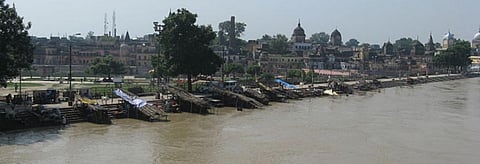

The Sarayu, the river on the banks of which the Hindu holy town of Ayodhya stands is choking to death for a variety of reasons, which the Uttar Pradesh government might well pay heed to.
The river was in the national spotlight around Diwali when a world record was created under the supervision of Chief Minister Yogi Adityanath. Over three lakh 'diyas' or earthen lamps were lit up simultaneously on its banks. Not only this, Yogi Adityanath has also announced that a 151 metre-tall statue of Lord Ram would be built on the river bank.
But news reports from 2017 say that a few sadhus of Ayodhya are not at all happy with the health of the river. Media reports say that 20 small and big drains flow into the Sarayu. A Public Interest Litigation has also been filed in 2014 before the Lucknow Bench of the Allahabad High Court.
The Sarayu originates from Lake Mansarovar in the Himalayas and is also known as the Ghaghra and the Manas Nandini. It merges with the Ganga in Bihar’s Saran district.
Reports say that the Sarayu, the lifeline of lakhs of people in Bihar and Uttar Pradesh, is choking to death. The nearly 1.5 kilomere-wide river has narrowed down to 30-40 metres owing to pollution and construction of the Pancheshwar dam upstream in Nepal according to a 2012 news report.
According to a 2007 paper published in the Journal of Industrial Pollution Control, the river gets polluted while passing through the twin cities of Ayodhya and Faizabad due to the wastes discharged from different small-scale industries like rice mills, petroleum workshops, railway workshops, dairies, laundries and cereal markets. Sewage, hazardous wastes from hospitals and pathological labs are also discharged into the river. These municipal wastes are mostly responsible for the deterioration of water quality in the river, says the report.
The plunging water-level is also reducing the flow in its tributaries and impacting agriculture in the area. Wherever the river feeds it, the groundwater has dipped and thousands of hand pumps have dried up as per 2012 news reports.
The Central Pollution Control Board (CPCB) report of 2016 shows that the river has faecal colliform in the range of 3,900 to 5,100 Most Probable Number or mpn/100ml, which is higher than the standard quantity of 2500 mpn/100 ml. Moreover, as per the recent data from the Union Ministry of Drinking Water and Sanitation, people near Saran are still going for open defecation near the river. The 2007 paper recorded Biological Oxygen Demand (BOD) values between 44.5-214.6 mg/L in five selected points to study the effect of municipal wastes on the river. The values are much higher than CPCB criteria of water quality for outdoor bathing (3mg/l). Hence, the river is not suitable at all for outdoor bathing. The CPCB 2016 data of water quality at Ayodhya’s main bathing ghat also shows a maximum BOD of 4 mg/l.
This perennial water source needs immediate attention as its clean-up will also contribute to the improvement of the Ganga’s health. If the government wants to clean the Ganga by March 2019, the pollution level of tributaries like the Sarayu should be taken care of.